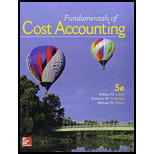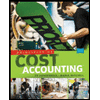
Concept explainers
a.
Prepare a production cost report using the weighted-average method.
a.
Explanation of Solution
Weighted average cost method:
Weighted average cost method is the method to find out the equivalent units in the
Compute the total units of prior department, materials, labor and manufacturing
| Particulars | Physical units | Prior department | Materials | Labor | Manufacturing overhead |
| Beginning work-in-process inventory | 75,000 | ||||
| Units started this period | 375,000 | ||||
| Total units | 450,000 | ||||
| Completed and transferred out | |||||
| Beginning work-in-process inventory | 75,000 | ||||
| Started and currently completed | 225,000 | ||||
| Total transferred out | 300,000 | 300,000 | 300,000 | 300,000 | 300,000 |
| Units in ending work-in-process inventory | 150,000 | 150,000 | 135,000(1) | 105,000(2) | 52,500(3) |
| Total units | 450,000 | 450,000 | 435,000 | 405,000 | 352,500 |
Table: (1)
Compute the cost per equivalent unit for prior department, materials, labor and manufacturing overhead:
| Particulars | Total | Prior department | Materials | Labor | Manufacturing overhead |
| Costs in beginning work-in-process inventory | $ 382,800 | $ 192,000 | $ 120,000 | $ 43,200 | $ 27,600 |
| Add: Current period costs | $ 1,865,400 | $ 960,000 | $ 576,000 | $ 216,000 | $ 113,400 |
| Total costs | $ 2,248,200 | $ 1,152,000 | $ 696,000 | $ 259,200 | $ 141,000 |
| Cost per equivalent unit: | |||||
| Prior department | $ 2.56(4) | ||||
| Materials | $ 1.60(5) | ||||
| Labor | $ 0.64(6) | ||||
| Manufacturing overhead | $ 0.40(7) |
Table: (2)
Compute the transferred out, ending inventory and total costs for prior department, materials, labor and manufacturing overhead:
| Particulars | Total | Prior department | Materials | Labor | Manufacturing overhead |
| Transferred out: | |||||
| Prior department | $ 768,000 | $768,000(8) | |||
| Materials | $ 480,000 | $480,000(9) | |||
| Labor | $ 192,000 | $192,000(10) | |||
| Manufacturing overhead | $ 120,000 | $120,000(11) | |||
| Total costs | $ 1,560,000 | ||||
| Work-in-process ending inventory | |||||
| Prior department | $ 384,000 | $384,000(12) | |||
| Materials | $ 216,000 | $216,000(13) | |||
| Labor | $ 67,200 | $67,200(14) | |||
| Manufacturing overhead | $ 21,000 | $21,000(15) | |||
| Total ending work-in-process inventory | $ 688,200 | ||||
| Total costs | $ 2,248,200 | $ 1,152,000 | $ 696,000 | $ 259,200 | $ 141,000 |
Table: (3)
Working note 1:
Compute the units in ending work-in-process inventory:
Working note 2:
Compute the units in ending work-in-process inventory:
Working note 3:
Compute the units in ending work-in-process inventory:
Working note 4:
Compute the cost per equivalent unit:
Working note 5:
Compute the cost per equivalent unit:
Working note 6:
Compute the cost per equivalent unit:
Working note 7:
Compute the cost per equivalent unit:
Working note 8:
Compute the transferred out costs:
Working note 9:
Compute the transferred out costs:
Working note 10:
Compute the transferred out costs:
Working note 11:
Compute the transferred out costs:
Working note 12:
Compute the costs assigned to ending work-in-process inventory:
Working note 13:
Compute the costs assigned to ending work-in-process inventory:
Working note 14:
Compute the costs assigned to ending work-in-process inventory:
Working note 15:
Compute the costs assigned to ending work-in-process inventory:
b.
Determine whether the targets assigned by the management have been achieved or not. Write a short report on the same.
b.
Explanation of Solution
Cost per equivalent unit:
Total amount accounted for and total units accounted are considered Compute the cost per equivalent unit.
Computed cost per equivalent units:
| Particulars | Cost per equivalent unit |
| Materials | $ 1.60 |
| Labor | $ 0.64 |
| Manufacturing overhead | $ 0.40 |
Table: (4)
Targeted cost per equivalent units:
| Particulars | Cost per equivalent unit |
| Materials | $ 1.60 |
| Labor | $ 0.80 |
| Manufacturing overhead | $ 0.36 |
Table: (5)
Relevance of reported computed result and targeted result for materials, labor and manufacturing overhead:
Only the target determined by the management for materials has been achieved. For labor and manufacturing overhead, the cost per equivalent unit has not achieved. The targeted cost per equivalent unit for labor was $0.80 but the actual cost per equivalent unit has been computed to $0.64. Thus, the target has been achieved and reduced further when computed using weighted-average method for labor.
And, the target set by the management for manufacturing overhead was $0.36 and the cost per equivalent unit has been computed to $0.40. The target has not been met by 11% difference approximately.
Want to see more full solutions like this?
Chapter 8 Solutions
GEN COMBO FUNDAMENTALS OF COST ACCOUNTING; CONNECT 1S ACCESS CARD
- Solvearrow_forwardA local bakery sells 12,000 loaves of sourdough bread each year. The loaves are ordered from an outside supplier, and it takes 4 days for each shipment of loaves to arrive. Ordering costs are estimated at $18 per order. Carrying costs are $6 per loaf per year. Assume that the bakery is open 300 days a year. What is the maximum inventory of loaves held in a given ordering cycle? Solutionarrow_forwardHello tutorarrow_forward
- A local bakery sells 12,000 loaves of sourdough bread each year. The loaves are ordered from an outside supplier, and it takes 4 days for each shipment of loaves to arrive. Ordering costs are estimated at $18 per order. Carrying costs are $6 per loaf per year. Assume that the bakery is open 300 days a year. What is the maximum inventory of loaves held in a given ordering cycle?arrow_forwardGiven solution for General accounting question not use aiarrow_forwardPlease provide correct solution and accounting questionarrow_forward
- Answer? ? Financial accounting questionarrow_forwardWhat is the maximum inventory of places held in a given ordering cyclearrow_forwardA local bakery sells 12,000 loaves of sourdough bread each year. The loaves are ordered from an outside supplier, and it takes 4 days for each shipment of loaves to arrive. Ordering costs are estimated at $18 per order. Carrying costs are $6 per loaf per year. Assume that the bakery is open 300 days a year. What is the maximum inventory of loaves held in a given ordering cycle? need your helparrow_forward
- What is the machine's book value at the end of 20X4?arrow_forwardAccounting solutionarrow_forwardA local bakery sells 12,000 loaves of sourdough bread each year. The loaves are ordered from an outside supplier, and it takes 4 days for each shipment of loaves to arrive. Ordering costs are estimated at $18 per order. Carrying costs are $6 per loaf per year. Assume that the bakery is open 300 days a year. What is the maximum inventory of loaves held in a given ordering cycle?arrow_forward
 Principles of Cost AccountingAccountingISBN:9781305087408Author:Edward J. Vanderbeck, Maria R. MitchellPublisher:Cengage Learning
Principles of Cost AccountingAccountingISBN:9781305087408Author:Edward J. Vanderbeck, Maria R. MitchellPublisher:Cengage Learning Cornerstones of Cost Management (Cornerstones Ser...AccountingISBN:9781305970663Author:Don R. Hansen, Maryanne M. MowenPublisher:Cengage LearningPrinciples of Accounting Volume 2AccountingISBN:9781947172609Author:OpenStaxPublisher:OpenStax College
Cornerstones of Cost Management (Cornerstones Ser...AccountingISBN:9781305970663Author:Don R. Hansen, Maryanne M. MowenPublisher:Cengage LearningPrinciples of Accounting Volume 2AccountingISBN:9781947172609Author:OpenStaxPublisher:OpenStax College Managerial AccountingAccountingISBN:9781337912020Author:Carl Warren, Ph.d. Cma William B. TaylerPublisher:South-Western College Pub
Managerial AccountingAccountingISBN:9781337912020Author:Carl Warren, Ph.d. Cma William B. TaylerPublisher:South-Western College Pub Managerial Accounting: The Cornerstone of Busines...AccountingISBN:9781337115773Author:Maryanne M. Mowen, Don R. Hansen, Dan L. HeitgerPublisher:Cengage Learning
Managerial Accounting: The Cornerstone of Busines...AccountingISBN:9781337115773Author:Maryanne M. Mowen, Don R. Hansen, Dan L. HeitgerPublisher:Cengage Learning Financial And Managerial AccountingAccountingISBN:9781337902663Author:WARREN, Carl S.Publisher:Cengage Learning,
Financial And Managerial AccountingAccountingISBN:9781337902663Author:WARREN, Carl S.Publisher:Cengage Learning,





